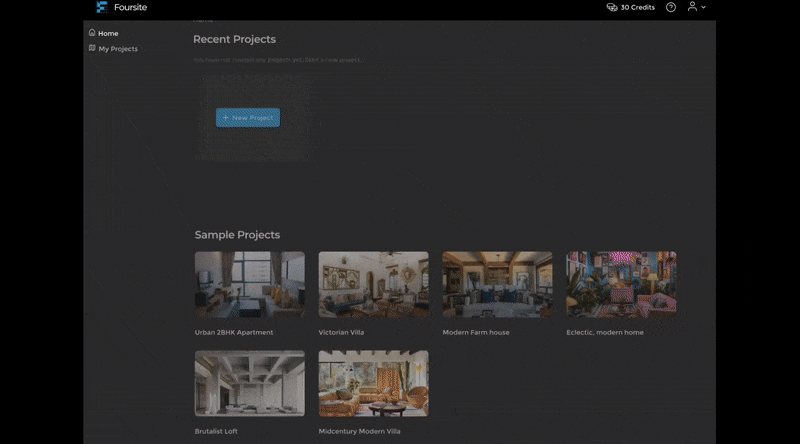
Blog Details

September 11, 2025
- AI Technology
- 3D Visualization
How AI Differs from Traditional 3D Rendering Software
Hemanth Velury
CEO & Co-FounderHow AI Differs from Traditional 3D Rendering Software
For decades, traditional 3D rendering software has been the essential tool for architects, designers, and developers to bring floor plans and blueprints to life, creating detailed photorealistic images that help envision spaces before they exist. While these tools remain powerful and indispensable, they demand significant technical skill and extensive time investments, often making them inaccessible for everyday users who simply wish to explore design ideas with ease. Today, the advent of artificial intelligence is revolutionizing the landscape of design visualization, enabling new platforms like Foursite to transform how we create, personalize, and interact with interior spaces. This blog explores the fundamental differences between AI-powered design tools and traditional 3D rendering software, highlighting how AI empowers creativity, accessibility, and an immersive design experience for everyone from professionals to homeowners.
From Labor-Intensive to Effortless Generation
Traditional 3D rendering software is renowned for its capability to produce stunningly realistic visuals, but it demands a painstaking process entirely rooted in manual effort. Users must begin from a blank 3D model and carefully construct every element, from walls and windows to textures, furniture, and lighting arrangements. Adjustments to even a single component necessitate rerunning the rendering process, which can take hours or even days, drastically slowing down design iteration and innovation.
AI-powered platforms such as Foursite dramatically shift this paradigm. By simply uploading a floor plan, users can instantly generate a navigable, empty 3D space, removing technical setup hurdles. From this foundation, AI facilitates the rapid creation of fully furnished, styled interior designs in minutes, freeing users to focus on creativity rather than the mechanics of rendering.
Beyond Realism: Toward Creative Personalization
While traditional rendering tools have long been celebrated for achieving near photographic realism, this emphasis on accuracy often restricts flexibility and creative experimentation. Changing the ambiance of a scene or experimenting with different design aesthetics typically requires labor-intensive redesigns and re-rendering.
AI-driven platforms redefine this approach by prioritizing design exploration over static realism. Foursite offers built-in design styles like Minimalist, Scandinavian, and Modern, enabling users to instantly reimagine spaces with different moods and palettes. Users can effortlessly swap color schemes, furniture styles, and decor options on the fly, fostering an environment where imagination and personalization flourish without constraints.

Static Images versus Interactive Environments
One of the most significant limitations of traditional 3D rendering software lies in its output formats. Most deliverables are static images or pre-rendered walkthrough videos that present only fixed perspectives chosen by the designer. These formats, while visually impressive, limit user engagement by denying interactive exploration of the space.
Foursite transcends these boundaries by creating fully interactive 3D environments where users can navigate their homes in real time. This immersive exploration provides a genuine understanding of spatial relationships, scale, and flow, aspects that static renderings simply cannot convey. Users can experience how furniture placement affects movement or see the view from their favorite seating areas, connecting with their designs on a profoundly intuitive level.
Accessibility for Everyone
Accessibility has historically been a major barrier in the realm of 3D design visualization. Traditional software demands technical expertise, steep learning curves, and often substantial financial investment, limiting high-quality renderings to trained professionals.
AI-enabled tools like Foursite democratize this space by removing these obstacles. Without needing any design or technical background, users can upload floor plans, explore empty rooms, and instantly transform them with curated styles and furnishings. This intuitive accessibility empowers homeowners, renters, and hobbyists to confidently engage in design decisions, while professional designers benefit from accelerated workflows and expanded creative options. Ultimately, AI levels the playing field, allowing anyone to harness the power of immersive design visualization.
Speed Meets Iteration
Speed and flexibility in the design process are paramount, yet traditional rendering is notoriously slow and costly to revise. Even minor changes necessitate new renders that consume precious time and resources, often discouraging experimentation.
AI redefines iteration by dramatically accelerating the creation and modification of designs. With Foursite, users can generate multiple variations rapidly, seeing the same living room transformed from minimalist whites to cozy Scandinavian aesthetics within moments. This ability to explore a broad spectrum of ideas without technical barriers unlocks unprecedented creativity and enables users to discover designs that truly resonate with them.
Why This Matters for the Future of Design
The divergence between AI-powered design tools and traditional 3D rendering extends beyond technical differences, it represents a philosophical shift in how design is conceived and experienced. Traditional methods focused on delivering polished, finalized visuals primarily for client approval, emphasizing presentation over process. AI emphasizes a collaborative, exploratory process where users actively shape their environments in real time, fostering creativity and involvement.
This evolution broadens the potential audience for design visualization, from professional architects to everyday individuals who want to envision and influence their living spaces before making decisions. The result is a more inclusive, dynamic, and engaging design process that transforms the way we relate to our environments.
Final Thoughts
While precision and technical detail will always anchor large-scale architectural projects, AI-powered design tools like Foursite are revolutionizing interior design and renovation visualization. Unlike traditional software that produces static images, AI creates immersive experiences that invite users to live within and shape their spaces virtually.
This transformation is not merely a technological upgrade but is a reimagination of design itself, making it more accessible, interactive, and imaginative. The future of design is no longer just about observing spaces but about experiencing and engaging with them before they physically exist. AI is ushering in this exciting new era and expanding the boundaries of creativity for all.

























